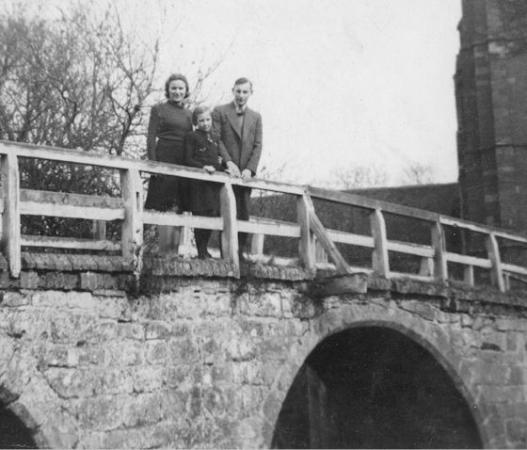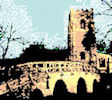An Evacuee's Story
Introduction
Having seen the devastation caused by the Condor Legion of the volunteer German Airforce in the Spanish Civil War between 1936 and 1939, the British Government were well aware that the same fate would no doubt fall on English cities in the Second World War. As a result, for safety reasons, the decision was taken to evacuate children from the cities to more rural areas of the country.
Leaving Home
In September 1939 nine years old Joan Harrison was living with her parents in Islington, North London. She had two siblings but they were much older than her. With her parents consent it was decided that she would be evacuated. Accompanied by teachers, complete with gas mask and label attached to their clothing, Joan and many other children were taken to St. Pancras Station with no idea of their final destination.
Arrival in Market Harborough
On arrival the children were taken to the Market where they were sorted out and allocated to the various villages and were then transported in coaches to these communities. Three thousand evacuees went to Market Harborough and were dispersed into the town and surrounding villages.

Ada and Arthur Warner with Joan and
Betty Wise (rear)
Arrival in Medbourne
Approximately fifty evacuees arrived in Medbourne and decisions were then made as to which host family individual children would be allocated, if at all possible siblings were to be placed with the same household. On arrival however, Joan realised she had left her sister's music case on the coach and burst into tears; P.C. Bradshaw and Special Constable Arthur Warner, on seeing her distress, proceeded to retrieve the missing case. The incident had a happy ending because Joan was placed with Arthur and his sister Ada Warner who lived on Spring Bank and owned the Butcher's Shop. Also living at the property were brother and sister George (referred to as Son) and Betty Wise who were the nephew and niece of the Warners.
Life in Medbourne
For the evacuees Medbourne was a very different environment from the London they had come from and most managed to adapt most happily. The evacuees played with the local children, very often on the Batters. They would visit the Blacksmith's forge, where Len Barlow allowed them to operate the bellows, and integrated generally into village life. They did odd jobs round the village and Joan delivered telegrams to the surrounding villages, for sixpence a mile! It was nine pence if delivered to Slawston, but nothing for coming back!

The Forge in Main Street
The evacuees were accompanied by their London teachers but there was not enough room in the village school so, at first, lessons were held in a room above the stables at the Nevill Arms. However in 1940, due to the so called "Phoney War", many children returned to their families in London, leaving just twenty evacuees including Joan. As a result all children were then taught in the village school, split into three classes, the teachers being Mrs Large, Mrs Tyler and Miss Rowe who came from London. At the age of eleven Joan passed the entrance examination and went to the Grammar School in Harborough.

Joan (centre) with her sister Rose and George Wise at a very familiar location.
Joan spent nearly six happy years with the Warners, who had nicknamed her "Chum". Although Arthur and Ada were quite strict (Chapel twice on Sunday!) they provided a loving and stable home, where Joan settled and was very happy.
Food was, of course, strictly rationed during the war. When an invitation came to take tea at the large house in Great Easton where they were billeted, there was great excitement, but were somewhat disappointed to be placed downstairs with the servants!
Contact with Family in London
During the whole of the nearly six years which Joan stayed in Medbourne, every Sunday without fail she would write a letter to her mother, and each week her mother would send a small parcel containing a few sweets, a comic and one shilling which Joan used to buy National Savings Stamps. On one occasion in the early days Arthur Warner drove her in his Morris 10 to visit her family but, due to subsequent petrol rationing, this trip was not repeated. However, once a year her mother travelled to visit her and at Christmas 1943 Joan paid a brief visit to her family.
Returning Home
By the Spring of 1945 Joan was nearly fifteen years old, the war was coming to an end and the time arrived to leave Medbourne. Joan's parents had a lucky escape during the bombing, a land mine, very close to their house had failed to explode. Not long after that Joan's parents moved to North West London to be near her father's work, travelling being very difficult when London was being bombed. So Joan returned to her family but in a different part of London; she was back in Medbourne visiting Arthur and Ada Warner in August to celebrate VJ day: August 15th 1945.
Conclusion
Joan never lost contact with her new family, Arthur and Ada Warner, Betty and George (Son), visiting regularly. In latter years Joan married and became Joan Browne and lived in South East London, a short distance from Betty and her husband.
The evacuation altered Joan's life completely and she will always be grateful to Arthur and Ada Warner and family for the love and friendship they gave her during the war and for the rest of their lives. Medbourne will always be her second home, and Joan and her family still visit to this day.
Acknowledgements
Contributed by Keith Sandars, September 2015, with considerable help from Joan Browne and Hilary Clifton Browne.

